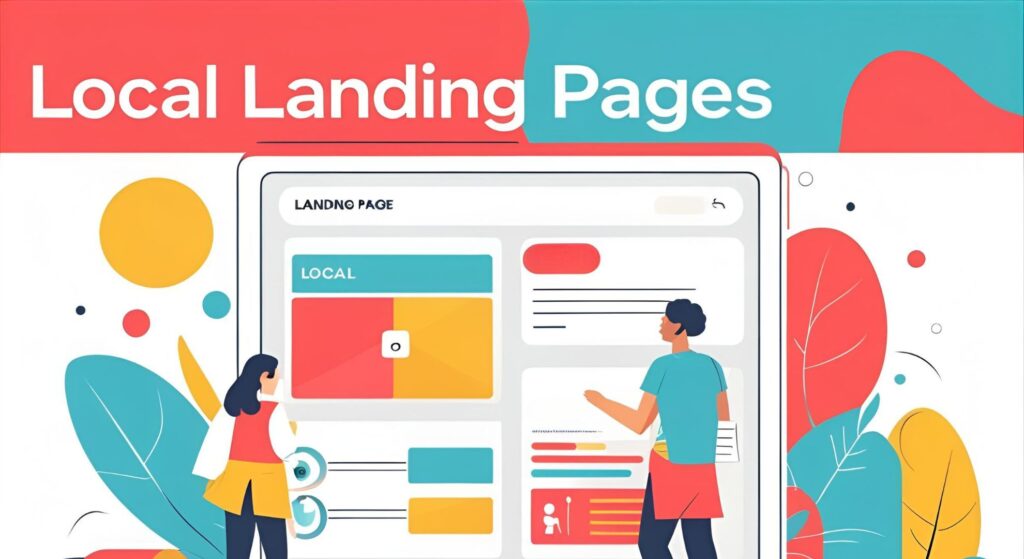Local landing page optimization represents a critical conversion opportunity that many businesses overlook, focusing primarily on traffic generation while neglecting the essential process of converting visitors into customers. Effective local landing pages bridge the gap between search intent and business objectives, providing targeted experiences that address specific geographic market needs while guiding prospects through optimized conversion paths. The challenge lies in creating pages that satisfy both local search algorithms and human visitors, balancing SEO requirements with persuasive design elements that drive meaningful business actions.
Modern local consumers exhibit distinct behavior patterns that differ significantly from general website visitors, requiring specialized optimization approaches that account for location-specific needs, mobile usage preferences, and immediate action intent. Local traffic typically arrives with higher commercial intent but also elevated expectations for relevance, authenticity, and immediate value demonstration. Success requires understanding these behavioral differences while implementing technical and content strategies that maximize conversion potential through superior user experience and strategic persuasion techniques.
Key Takeaways
• Location-specific content personalization increases conversion rates by addressing local market needs, community connections, and geographic relevance that resonates with target audiences
• Mobile-first optimization proves essential for local landing page success, with over 80% of local searches occurring on mobile devices requiring optimized user experiences
• Trust signal integration including local testimonials, area-specific case studies, and community involvement builds credibility that directly influences conversion decisions
• Call-to-action optimization tailored to local customer journey stages maximizes conversion potential through strategic placement and location-appropriate messaging
• Page speed and technical performance directly impact local conversion rates, with mobile loading speed particularly critical for maintaining visitor engagement
• Social proof and review integration leverages local reputation to build confidence and encourage immediate action from prospects familiar with community feedback patterns
Overview
Converting local traffic requires comprehensive landing page strategies that combine technical optimization with persuasive content development tailored to geographic market characteristics. This guide examines proven methodologies for creating high-converting local landing pages that serve both search engine requirements and business conversion objectives. The approach emphasizes practical implementation strategies that balance local SEO benefits with conversion rate optimization principles, enabling businesses to maximize return on investment from local search traffic while building sustainable competitive advantages through superior user experience design.
Understanding Local Visitor Behavior and Intent
Local landing page visitors demonstrate unique behavioral patterns that distinguish them from general website traffic, exhibiting higher commercial intent combined with specific geographic expectations that influence conversion decisions. Research indicates local searchers are 50% more likely to visit physical locations within 24 hours of conducting local searches, creating immediate conversion opportunities for businesses that provide relevant, actionable information. Understanding these intent patterns enables development of landing page experiences that align with visitor expectations while guiding prospects toward desired business outcomes.

Geographic relevance expectations significantly influence local visitor engagement, with users seeking immediate confirmation that businesses serve their specific areas and understand local market conditions. Landing pages must demonstrate local knowledge through neighborhood references, area-specific information, and community connections that establish credibility and relevance. This geographic validation process occurs within seconds of page loading, making immediate local relevance demonstration critical for maintaining visitor engagement.
Mobile usage dominates local search behavior, with over 80% of local searches occurring on mobile devices during moments of immediate need or proximity-based decision making. This mobile-first reality demands landing page optimization that prioritizes mobile user experience while ensuring seamless functionality across all device types. Mobile optimization extends beyond responsive design to encompass touch-friendly interfaces, simplified navigation, and streamlined conversion processes that accommodate on-the-go usage patterns typical of local searchers.
Customer Journey Analysis
Local customer journeys typically involve shorter decision-making timeframes compared to general purchase processes, with proximity and immediate availability often serving as primary decision factors. Landing page optimization must account for this accelerated decision timeline by providing comprehensive information quickly while minimizing friction in conversion processes. Understanding local customer journey stages enables strategic content placement and conversion path design that supports rapid decision making.
The relationship between online research and offline action becomes particularly important for local landing page strategy, with many visitors using online information to prepare for phone calls, visits, or immediate purchases. Landing pages should provide information that supports both immediate online conversions and facilitates seamless transition to offline interactions through clear contact information, directions, and preparation details.
Technical Foundation and Performance Optimization
Technical performance serves as the foundation for successful local landing page conversion, with page loading speed directly correlating with bounce rates and conversion achievement. Local searchers demonstrate even lower tolerance for slow-loading pages compared to general web users, making performance optimization critical for maintaining engagement. Google’s Core Web Vitals provide essential metrics for measuring and optimizing local landing page performance, with particular attention required for mobile loading speeds.
Mobile optimization extends beyond responsive design to encompass touch-friendly interfaces, appropriate font sizes, and streamlined navigation that supports single-handed mobile usage common in local search scenarios. Local landing pages must function perfectly across various mobile devices and connection speeds, ensuring consistent user experiences regardless of technical constraints. Implementation of Accelerated Mobile Pages (AMP) can provide performance advantages for local landing pages, particularly in competitive markets where loading speed advantages translate directly into conversion improvements.
Schema markup implementation enhances local landing page effectiveness by providing search engines with structured data about business locations, services, and local relevance indicators. LocalBusiness schema markup enables enhanced search result appearances including business hours, contact information, and customer ratings that improve click-through rates from local search results. Proper schema implementation also supports voice search optimization, increasingly important for local search queries.
Core Web Vitals Optimization
Largest Contentful Paint (LCP) optimization ensures local landing pages load primary content quickly, critical for maintaining visitor attention during mobile browsing sessions. Techniques include image optimization, critical CSS prioritization, and server response time improvements that accelerate initial page rendering. Local landing pages should achieve LCP scores under 2.5 seconds to maintain competitive conversion performance.
Cumulative Layout Shift (CLS) optimization prevents visual instability that can disrupt conversion processes, particularly important for mobile users attempting to complete contact forms or click call-to-action buttons. Proper sizing attributes for images, videos, and dynamic content elements prevent layout shifts that could interrupt conversion activities.
Location-Specific Content Strategy
Effective local landing pages require content strategies that demonstrate genuine connection to geographic markets through neighborhood-specific information, local market knowledge, and community involvement. Content development should incorporate location-specific keywords naturally while providing substantive value that addresses local customer needs and concerns. Hyper-local content approach includes references to local landmarks, area businesses, community events, and regional characteristics that establish authentic local presence.
Service area coverage content helps visitors understand geographic boundaries while supporting local search visibility for surrounding communities. Detailed service area descriptions should include specific neighborhoods, zip codes, and proximity indicators that help potential customers determine service availability. This geographic specificity supports both user experience and local search optimization by providing clear relevance signals to search engines.
Community involvement content builds trust and local credibility through documentation of local partnerships, event sponsorships, charity participation, and neighborhood engagement activities. This content demonstrates genuine community investment while providing unique differentiators that competitors may lack. Local involvement content should include specific details about partnerships, event participation, and community contributions that verify authentic local engagement.
Neighborhood-Specific Customization
Individual neighborhood landing pages enable highly targeted content that addresses specific community characteristics, demographics, and local preferences. This granular approach allows businesses serving multiple areas to provide customized experiences that feel personally relevant to visitors from different neighborhoods. Neighborhood-specific content should reference local schools, shopping areas, transportation options, and community features that demonstrate intimate local knowledge.
Local market insights integration involves incorporating area-specific trends, preferences, and concerns into landing page content that resonates with target audiences. This might include seasonal considerations, local economic factors, or community-specific needs that influence purchasing decisions. Market insight integration demonstrates expertise while providing value that generic landing pages cannot match.
Trust Signal Integration and Social Proof
Local landing pages benefit significantly from trust signals that leverage community reputation and local credibility indicators to influence conversion decisions. Local testimonials from recognizable community members, area businesses, or neighborhood references provide powerful social proof that resonates more strongly than generic testimonials from distant customers. Testimonial content should include specific location references, local context, and verifiable details that support authenticity.

Local case studies and success stories provide detailed examples of business performance within specific geographic markets, demonstrating track record and results that potential customers can relate to directly. Case study content should include local challenges, market-specific solutions, and measurable outcomes that prove business effectiveness within the target market area. These detailed examples build confidence while providing concrete evidence of local expertise.
Review integration from Google My Business, Yelp, and other local platforms provides current social proof that influences conversion decisions. Strategic review display should highlight recent, relevant feedback while maintaining authentic representation of customer experiences. Review integration should include response examples that demonstrate customer service quality and commitment to customer satisfaction.
Community Recognition and Awards
Local awards, media coverage, and community recognition provide credibility indicators that influence local conversion decisions. Recognition content should include specific details about awards, media mentions, and community honors that demonstrate business standing within the local market. This recognition serves as third-party validation that supports conversion decisions.
Professional credentials and local certifications relevant to the business and service area provide additional trust signals that support conversion decisions. Certification display should include relevant local licensing, industry credentials, and professional memberships that demonstrate qualifications and compliance with local requirements.
Call-to-Action Optimization for Local Conversions
Local landing page call-to-action optimization requires understanding the specific actions local customers prefer when engaging with businesses, including phone calls, direction requests, appointment scheduling, and immediate contact needs. CTA design and placement should prioritize mobile-friendly interaction while providing multiple conversion options that accommodate different customer preferences and readiness levels.
Action-specific CTA optimization involves creating distinct calls-to-action for different visitor intents including immediate service needs, information requests, appointment scheduling, and consultation bookings. Multiple CTA options enable visitors to engage at their preferred commitment level while providing businesses with various conversion opportunities from single traffic sources.
Geographic relevance in CTA messaging enhances conversion effectiveness by incorporating location-specific language, area references, and community connections that feel personally relevant to local visitors. CTA text should reflect local market characteristics while maintaining clarity and urgency that motivates immediate action.
Conversion Path Streamlining
Form optimization for local conversions involves minimizing required information while capturing essential details for follow-up contact and service delivery. Local conversion forms should prioritize phone contact information, service areas, and immediate need indicators that enable rapid response. Form design should accommodate mobile completion while preventing abandonment through excessive complexity.
Contact method diversification provides multiple options for visitor engagement including phone calls, online forms, chat systems, and appointment scheduling tools that accommodate different communication preferences. Local customers often prefer immediate phone contact, making prominent phone number display and click-to-call functionality essential for mobile optimization.
Mobile Experience and User Interface Design
Mobile-first design approach ensures local landing pages provide superior experiences on smartphones and tablets where local searches predominantly occur. Interface design should prioritize essential information presentation while maintaining intuitive navigation that supports single-handed mobile usage. Visual hierarchy must guide visitors efficiently toward conversion actions without overwhelming small screen interfaces.
Touch-friendly interface elements including appropriately sized buttons, adequate spacing, and intuitive gestures enhance mobile user experience while reducing conversion friction. Local landing pages should eliminate elements that cause mobile usability issues including hover-dependent functionality, small text sizes, and complex navigation structures that impede mobile conversion processes.
Loading optimization for mobile connections ensures consistent performance across various network conditions common in mobile usage scenarios. Progressive loading techniques, image optimization, and content prioritization maintain engagement while pages fully load, preventing abandonment during slower connection periods.
Responsive Design Implementation
Cross-device consistency maintains user experience quality across desktop, tablet, and mobile platforms while ensuring conversion functionality operates properly on all devices. Responsive design implementation should prioritize mobile experience while maintaining desktop functionality for users accessing landing pages through various devices.
Navigation simplification for mobile interfaces reduces complexity while maintaining access to essential information and conversion opportunities. Mobile navigation should prioritize local contact information, service details, and conversion actions while minimizing menu complexity that could confuse or distract mobile users.
Content Personalization and Dynamic Elements
Geographic personalization enables dynamic content presentation based on visitor location data, providing customized experiences that feel specifically relevant to individual users. Personalization implementation can include location-specific headlines, area-relevant service emphasis, and neighborhood-specific contact information that enhances perceived relevance and conversion likelihood.
Time-sensitive content integration addresses immediate local needs through current promotions, availability updates, and timely service information that creates urgency and encourages immediate action. Dynamic content should reflect current business conditions while maintaining accuracy and relevance for local visitors seeking immediate solutions.
Weather and seasonal considerations influence local customer needs, enabling content personalization that addresses current conditions and seasonal requirements. Seasonal content adaptation demonstrates market awareness while providing timely relevance that competitors with static content cannot match.
Dynamic Content Management
Content management systems that support location-based personalization enable efficient maintenance of multiple market-specific landing pages while maintaining consistency and accuracy across geographic markets. Dynamic content management should balance automation efficiency with local market customization requirements.
Real-time information integration including business hours, availability, pricing, and service updates ensures landing page accuracy while providing current information that supports immediate conversion decisions. Real-time content management prevents visitor disappointment while maintaining credibility through accurate information presentation.
Performance Measurement and Optimization
Conversion tracking implementation measures local landing page effectiveness through comprehensive analytics that connect visitor behavior with business outcomes. Tracking systems should monitor conversion rates, source attribution, and customer value to enable data-driven optimization decisions. Local conversion tracking must account for both online and offline conversion paths that result from landing page visits.

A/B testing methodologies enable systematic optimization of local landing page elements including headlines, content presentation, CTA placement, and design elements that influence conversion performance. Testing should focus on elements most likely to impact local conversion behavior while maintaining statistical significance for reliable optimization decisions.
Geographic performance analysis reveals conversion variations across different market areas, enabling optimization strategies tailored to specific local market characteristics. Performance segmentation by location helps identify successful strategies that can be replicated while revealing areas requiring additional optimization attention.
Analytics Integration and Reporting
Google Analytics configuration for local landing page tracking enables detailed analysis of visitor behavior, conversion paths, and performance metrics that inform optimization strategies. Analytics implementation should include local-specific goal tracking, geographic performance analysis, and conversion attribution that supports strategic decision making.
Heat mapping and user behavior analysis provide insights into visitor interaction patterns that reveal optimization opportunities including content engagement, navigation usage, and conversion friction points. Behavior analysis enables user experience improvements that directly impact conversion performance.
Frequently Asked Questions
What makes local landing pages different from general landing pages? Local landing pages require geographic relevance, community connections, and location-specific content that addresses local market needs. They must also accommodate mobile-first usage patterns and higher commercial intent typical of local searchers while incorporating local trust signals and area-specific social proof.
How important is mobile optimization for local landing page conversions? Mobile optimization is critical, with over 80% of local searches occurring on mobile devices. Local landing pages must provide superior mobile experiences including fast loading speeds, touch-friendly interfaces, and streamlined conversion processes that accommodate on-the-go usage patterns.
What trust signals work best for local landing page conversions? Effective trust signals include local testimonials with community references, area-specific case studies, Google My Business reviews, local awards and recognition, professional credentials, and community involvement documentation that demonstrates authentic local engagement and credibility.
How should businesses optimize calls-to-action for local conversions? Local CTA optimization should prioritize mobile-friendly actions including click-to-call functionality, direction requests, and appointment scheduling. Multiple CTA options should accommodate different visitor intents while incorporating location-specific language that feels personally relevant to local audiences.
What content elements are essential for local landing page conversions? Essential content includes service area coverage, neighborhood-specific information, local contact details, community involvement, customer testimonials from local clients, local market expertise demonstration, and area-specific service adaptations that address local needs and preferences.
How can businesses measure local landing page conversion effectiveness? Measurement should include conversion rate tracking, source attribution analysis, customer acquisition cost assessment, geographic performance comparison, and both online and offline conversion attribution that accounts for the relationship between online research and offline actions common in local customer journeys.
What technical requirements are most important for local landing page performance? Critical technical requirements include Core Web Vitals optimization, mobile-first responsive design, local schema markup implementation, fast loading speeds across devices, and touch-friendly interface elements that support single-handed mobile usage typical of local searchers.
How should businesses handle multiple location landing pages? Multi-location strategies require unique content for each location, consistent branding and messaging, location-specific optimization, centralized management systems, and geographic performance tracking that enables location-specific optimization while maintaining overall campaign coherence and efficiency.
Optimizing Local Landing Pages for Higher ConversionsSources
Conversion Rate Optimization:
Local SEO and Geographic Targeting:
- Google My Business Optimization Guide
- Local Search Association Resources
- BrightLocal Local SEO Research
Mobile Optimization and Performance:
Analytics and Performance Tracking:
- Google Analytics 4 Documentation
- Google Tag Manager Guide
- Heat Mapping and User Behavior Analysis
Trust Signals and Social Proof:
- Review Management Best Practices
- Local Business Schema Implementation
- Customer Testimonial Optimization
Transform your local traffic into customers with expertly optimized landing pages that convert visitors into revenue. Cloud 7 Agency specializes in creating high-converting local landing pages that balance search engine optimization with persuasive design elements, delivering measurable conversion improvements through strategic content development and technical optimization.Contact our conversion optimization specialists today to discover how optimized local landing pages can maximize your return on local search investment while building sustainable competitive advantages in your market.

